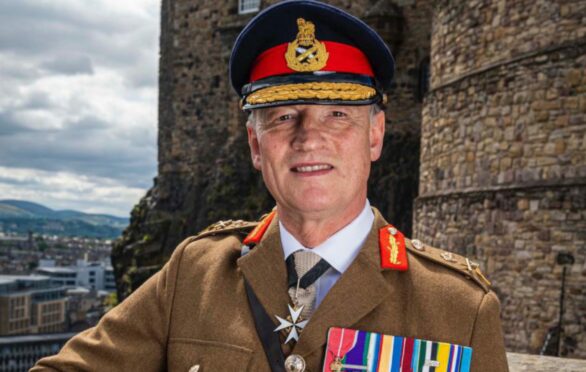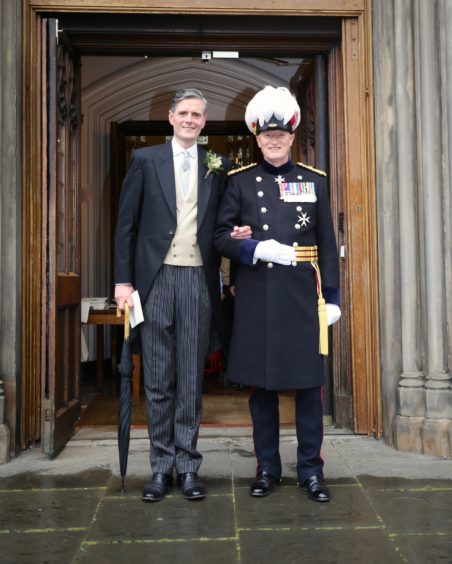
His military career spans more than four decades and has been founded on courage, integrity and, for half of those 42 years, a secret.
When Major General Alastair Bruce first joined the Army in 1979, the now-61-year-old had to hide his sexuality and, only after the law changed in 2000 to allow members of the LGBTQ+ community to serve could he finally, tentatively, be himself.
Now, Bruce has made the ultimate declaration of love, having married his partner, Stephen Knott, admitting that “attitudes change but love is constant” after their wedding ceremony earlier this month. The couple met on a cruise in the Great Barrier Reef in 2001, and although same-sex relationships were no longer prohibited within the Army, both still took great care to live their life as privately as possible.
“Having been careful about how I lived throughout my military career, I was not quick to be open about my sexuality and my private life,” said Bruce, who began his Army service with the 2nd Battalion Scots Guards, and is now Governor of Edinburgh Castle.
“So, Stephen and I lived a strange life, really. If we were walking together in a town or city where I might bump into somebody from the Army, we had a tradition that he would walk on to the next shop and wait for me so that we didn’t appear to be together.
“It’s extraordinary now, but I suppose it was the inevitable way I lived as a result of having to keep that side of my life quiet.”
Going public
After so many years living quietly, finding the courage to talk publicly about his sexuality was, Bruce admitted, enormously difficult.
He continued: “It’s not that one would have just been forced to resign because, if you were like me, you were not tolerated in the Armed Forces. It was worse than that. I would have been dishonourably discharged, which is as dismal as it sounds. So, I conducted my private life with extreme care, and made sure nobody knew.
“I don’t think I was living two lives, I was responding to the situation I was in. I was also quite cautious about my family and friends not knowing, too.
“It was just what I thought the lot was for people like me. I don’t think I resented it, I just accepted that this was the environment I was in, and in order to survive I had to adapt. After a lifetime of hiding, it’s quite difficult to take confidence from the change of a rule. I saw no need to trumpet anything – I had been very happy keeping very quiet.
“In fact, if you’ve made the whole language of your togetherness secretive, it’s quite difficult to garland it with openness. So, it took me quite a bit of time.
“Of course, when I did tell my friends and family that I was gay, they all told me they had known, and have been terribly supportive. I know that is not everyone’s experience.”
His wedding on July 3 at St John’s Church, officiated by the Bishop of Edinburgh, makes him the highest-ranking British Army Officer to be in a same-sex marriage, and being able to say their vows in a church was another momentous milestone for the pair.
He explained: “I had never thought marriage would be something within my grasp. It’s all been very remarkable, and we’ve been delighted that we’ve been able to do it.
“I am very fortunate that the Episcopal Church of Scotland permits people like Stephen and I to get married. When I went to see the Bishop of Edinburgh to say thank you for the fact that his church marries same-sex people, he simply responded, ‘We don’t, we marry people’.
“I thought that was the loveliest and most accepting message that I have received.”
In 2019, Bruce was appointed as an Army race advocate to help improve the lived experience of all members of the Army, something he says was influenced by his own experience, which he described as being “tremendously short on courage” when it came to his sexuality.
He hopes now being open about his private life will encourage more young recruits to do the same.
He continued: “I do hope that if our marriage does anything, it gives young men and women, who are like me, or who have other differences that are not necessarily the ones that I had, can see Stephen and I married publicly, and they can feel that it’s all right to be themselves.
“If I achieve that with one soldier, or one person or one Scot, I will feel we’ve been able to do something.”

Enjoy the convenience of having The Sunday Post delivered as a digital ePaper straight to your smartphone, tablet or computer.
Subscribe for only £5.49 a month and enjoy all the benefits of the printed paper as a digital replica.
Subscribe © Vikki Bruce
© Vikki Bruce